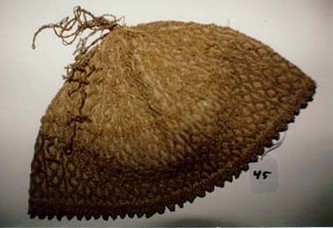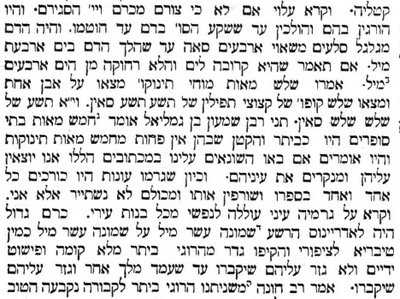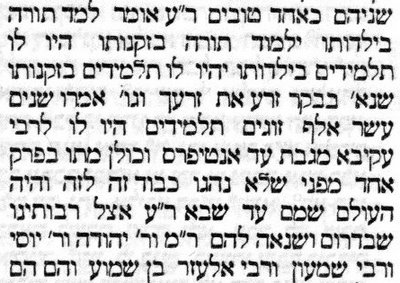Elisha ben Abuya IV
As was noted in the previous installment, my translations of the Palestinian material are taken from Jeffrey L. Rubenstein, Talmudic Stories: Narrative Art, Composition, and Culture (Baltimore: Johns Hopkins University Press, 1999), 82-86. Rubenstein's scriptural quotations are all taken from JPS. Emphasis and parentheses are his.
וכל דא מן הן אתה ליה אלא פעם אחת היה יושב ושונה בבקעת גינוסר וראה אדם אחד עלה לראש הדקל ונטל אם על הבנים וירד משם בשלוה למחר ראה אדם אחר שעלה לראש הדקל ונטל את הבנים ושילח את האם וירד משם והכישו נחש ומת אמר כתיב שלח תשלח את האם ואת הבנים תקח לך למען ייטב לך והארכת ימים איכן היא טובתו של זה איכן היא אריכות ימיו של זה ולא היה יודע שדרשה רבי יעקב לפנים ממנו למען ייטב לך לעולם הבא שכולו טוב והארכת ימים לעתיד שכולו ארוך
pHag 77b
And why did all this happen to him?
Once he was sitting and learning in the plain of Genesaret and he saw a man ascend to the top of a palm and take the mother bird together with her young and descend safely from there. The next day he saw a man ascend to the top of the palm and take the young after shooing away the mother. He descended from there, and a snake bit him and he died. He said, "It is written, [Do not take the mother together with her young.] Let the mother go, and take only the young, in order that you may live well and have a long life (Deut 22:6). Where is the welfare of this man? Where is the long life of this man?"
He did not know that R. Yaakov had previously expounded it: "In order that you may live well - in the world to come that is all good. And have a long life - in the future that is all long."
[Note: It would appear from Rubenstein's translation that the text that he is using lacks the full scriptural quote. As I am taking his translation from him directly, I have copied it as he prints it, although the full quote from Deuteronomy is present in the Hebrew above]
We noted before in relation to the first of EbA's discussions with Rabbi Meir that theodicy appears to be an issue with which EbA struggles. This was apparant in his frequent laments over the passing of Rabbi Akiva, and it is especially apparant here in this (possibly) mythologised understanding of what had led EbA to apostasy in the first place. It is doubtful, should we take this story at face value, that the simplistic rationale of Rabbi Yaakov could have assuaged the concerns felt by EbA.
ויש אומר ע"י שראה לשונו של רבי יהודה הנחתום נתון בפי הכלב שותת דם אמר זו תורה וזו שכרה זהו הלשון שהיה מוציא דברי תורה כתיקנן זה הוא הלשון שהיה יגיע בתורה כל ימיו זו תורה וזו שכרה דומה שאין מתן שכר ואין תחיית המתים
pHag 77b
Some say [it happened to him] because he saw the tongue of R. Yehuda the Baker dripping blood in the mouth of a dog. He said, "This is Torah and this is its reward? This is the tongue that used to bring forth fitting words of Torah? This is the tongue that labored in Torah all its days? It seems that there is no giving of reward and there is no resurrection of the dead."
[Note: Again, the text that I have reproduced above appears to differ from Rubenstein's text. My text, as written above, repeats the phrase, "This is Torah and this is its reward?" prior to EbA presenting his conclusions]
The crucial part of this incident lies in EbA's exclamation. This same exclamation (זו תורה וזו שכרה) can be found in two other places, both in reference to the death of Rabbi Akiva. The first is in bMen 29b where the exclamation is made by Moses after having been shown both the teachings and the fate of Rabbi Akiva; the second is in bBer 61b where it is made by the angels after Rabbi Akiva dies. The connection to these two sources is clearly not accidental and, while it is Rabbi Yehuda's death that EbA is witnessing, it is certainly also to Rabbi Akiva that he is alluding.
EbA's remarks here are passionate but, at the same time, slightly inappropriate. There is no apparant connection between dismemberment and the impossibility of resurrection, save for the most simplistic understandings of the latter. That EbA has progressed from denying reward for the righteous to denying resurrection of the dead is illogical, and probably being presented as indicative of an irrational and easily excitable mind.
וי"א אמו כשהיתה מעוברת בו היתה עוברת על בתי ע"ז והריחה מאותו המין והיה אותו הריח מפעפע בגופה כאירסה של חכינה
pHag 77b
And some say that when his mother was pregnant with him she would pass by houses of idol worship and smell that stuff. The aroma seeped into his body like the venom of a snake.
Once more we are given a reason that pins the blame on somebody other than EbA himself: this time, his mother. The accusation that she used to walk past houses of idol worship and smell the emanating smoke (presumably of incense) implies deliberate action, and casts aspersions on her own level of piety.
לאחר ימים חלה אלישע אתון ואמרון לר"מ הא רבך באיש אזל בעי מבקרתיה ואשכחיה באיש א"ל לית את חזר בך א"ל ואין חזרין מתקבלין א"ל ולא כן כתיב תשב אנוש עד דכא עד דיכדוכה של נפש מקבלין באותה שעה בכה אלישע ונפטר ומת והיה ר"מ שמח בלבו ואומר דומה שמתוך תשובה נפטר רבי
pHag 77b-c
Years later Elisha became sick. They came and said to R. Meir, "Behold your master is sick." He went desiring to visit him and found him sick. He said to him, "Will you not repent?" He said to him, "If one repents, is it accepted?" He said, "Is it not written, You return man to dust (dakka'), [You decreed, Return you mortals] (Ps 90:3)? Until life is crushed (dikhdukha) it is accepted." At that point Elisha wept and passed away and died. R. Meir rejoiced in his heart and said, "It seems that my master died repenting."
This scene reminds me of the closing scene of Marlowe's Dr. Faustus, where Faust is encouraged to repent but, instead, seals anew his pact with Lucifer. In our case, however, there is every indication to assume that EbA repented, save perhaps the lingering doubt made possible by the narrator's failure to relate EbA's final words. If there should be any doubt (and it is my opinion that there should not), it may also be strengthened by the usage of the word, דומה ('it seems'): the same word that EbA employed in making his erroneous deduction concerning the resurrection.
A couple of points relating to Rubenstein's translation before we move on. The text does not specify that this occurred after some years but, rather, after 'days'. This is a reference to a passing of time that may have been measured in years, but may not have been. In a moment we shall see another example where Rubenstein renders it as "years" correctly although, in this case, it is equally likely that it occurred within a week of EbA's three conversations with Rabbi Meir. In addition to this, the word that the text uses to describe EbA's sickness is באיש, which literally means 'bad'. It is in a 'bad' state that Meir is told of EbA, and in a 'bad' state in which he is found. This word can also carry connotations of wickedness, and this ambiguity should not be passed over lightly.
מן דקברוניה ירדה האש מן השמים ושרפה את קברו אתון ואמרון לר"מ הא קבריה דרבך אייקד נפק בעי מקברתיה ואשכחיה אייקד מה עבד נסב גולתיה ופרסיה עלוי אמר ליני הלילה ליני בעולם הזה שדימה ללילה והיה בבוקר זה העולם הבא שכולו בוקר אם יגאלך טוב יגאל זה הקב"ה שהוא טוב דכתיב ביה טוב ה' לכל ורחמיו על כל מעשיו ואם לא יחפוץ לגאלך וגאלתיך אנכי חי ה' ואיטפיית
pHag 77c
After they buried him fire came down from heaven and burned his grave. They came and said to R. Meir, "Behold, your master's grave is burning." He left desiring to visit it and found it burning. What did he do? He took his cloak and spread it upon him. He said, "Stay the night... (Ruth 3:13). Stay the night (Ruth 3:13) - in this world that is similar to night. Then in the morning (Ruth 3:13) - this is the world to come that is completely morning. If he will redeem you, good (Ruth 3:13) - this refers to the Holy One, Blessed be He, who is good, as it says, He is good to all and his mercy is upon all his creatures (Ps 145:9). But if He does not want to redeem you, I will redeem you myself, as God lives! (Ruth 3:13)." And it was extinguished.
This section serves as something of a finale to the narrative. Once more (for the third time) "they" have come to inform Rabbi Meir of something relating to his master. Initially it was to tell him that his master was outside, then it was to inform him that his master was ill (lit. 'bad'), and now it is to tell him that his master's grave is burning. What is more, this burning is reminiscent of the fire in Abuya's household when Rabbis Eliezer and Yehoshua were turning words of Torah.
When Rabbi Meir spreads his cloak it is over EbA's grave, paralleling the request of Ruth for Boaz to spread his cloak over her in Ruth 3. The response of Boaz to Ruth is explained, line by line, as being a reference to Rabbi Meir redeeming EbA from some unmentioned post-mortem torment. In that sense, this section is an inverse of EbA's story concerning his father. In that story it was words of Torah that brought a fire so great that Abuya thought the sages had come to demolish his house, but in this story Rabbi Meir's words of Torah are powerful enough that they succeed in extinguishing a fire that came to wreak havoc on EbA's grave.
אמרון לר"מ אין אמרון לך בההוא עלמא למאן את בעי למבקרה לאבוך או לרבך אמר לון אנא מיקרב לרבי קדמיי ובתר כן לאבא אמרון ליה ושמעין לך אמר לון ולא כן תנינן מצילין תיק הספר עם הספר תיק תפילין עם התפילין מצילין לאלישע אחר בזכות תורתו
pHag 77c
They said to R. Meir, "If they say to you in that world, 'Whom do you desire to visit?' [will you say] your father or your master?" He said to them, "I will first approach my master and then my father." They said to him, "Will they listen to you?" He said to them, "Did we not learn, They save the casing of the scroll with the scroll, the casing of the phylacteries with the phylacteries (=mShab 16:1)? They save Elisha-Aher for the merit of his Torah."
This section, and the one following, serve as the climax to the Palestinian Talmudic story. It is here that we see the main concern rising to the fore, as we have tentatively sensed it already. If EbA is perceived as genuinely wicked (murdering children, violating the Sabbath, etc): why are his teachings preserved? May we preserve the nectar of a fruit that is rotten? Or - in this case - if the fruit is good, must the husk also be maintained? It would appear that the answer is in the affirmative. This is indicated, not only in Rabbi Meir's response here and in Rebbe's response in the following narrative, but in the very inclusion of these stories within the Talmud, and in the inclusion of EbA's teachings.
לאחר ימים הלכו בנותיו ליטול צדקה מרבי גזר רבי ואמר אל יהי לו מושך חסד ואל יהי חונן ליתומיו אמרו לו רבי אל תבט במעשיו תבט בתורתו באותה השעה בכה רבי וגזר עליהן שיתפרנסו אמר מה אם זה שיגע בתורה שלא לשום שמים ראו מה העמיד מי שהוא יגע בתורה לשמה על אחת כמה וכמה
pHag 77c
Years later his daughters went to ask for alms from Rabbi [Yehuda HaNasi].
Rabbi decreed and said, "May no one show him mercy, may none pity his orphans (Ps 109:12)." They said to Rabbi, "Do not look at his deeds. Look at his Torah."
At that point Rabbi wept and decreed that they be supported.
He said, "If this one, who laboured in Torah not for the sake of heaven - see what [children] he raised, he who laboured in Torah for its own sake, how much the more so!"









